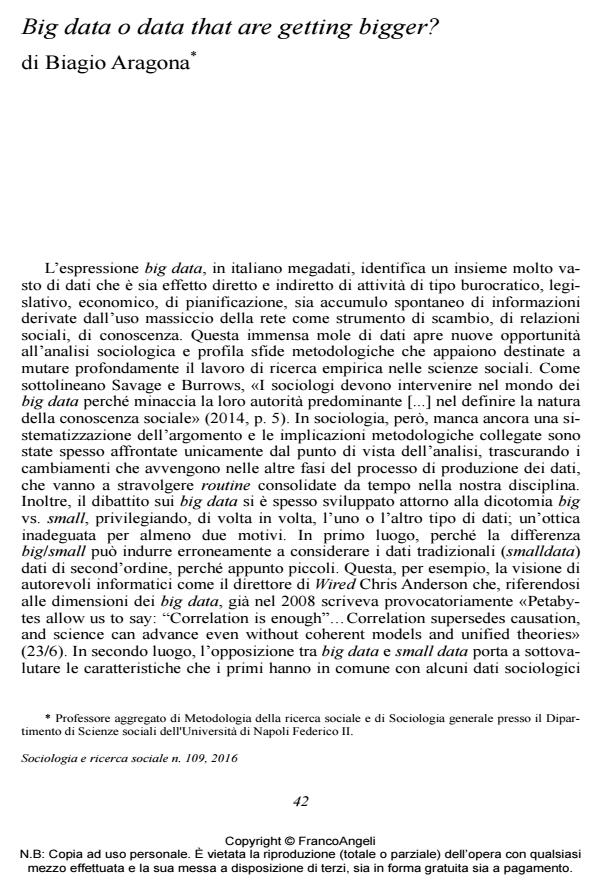Big data or Data that is Getting Bigger?
Journal title SOCIOLOGIA E RICERCA SOCIALE
Author/s Biagio Aragona
Publishing Year 2016 Issue 2016/109 Language Italian
Pages 12 P. 42-53 File size 59 KB
DOI 10.3280/SR2016-109005
DOI is like a bar code for intellectual property: to have more infomation
click here
Below, you can see the article first page
If you want to buy this article in PDF format, you can do it, following the instructions to buy download credits

FrancoAngeli is member of Publishers International Linking Association, Inc (PILA), a not-for-profit association which run the CrossRef service enabling links to and from online scholarly content.
The potential of Big Data for sociology is being recognized broadly, but there is still a wide gap between its potential and its realization. One of the reasons is that Big Data encloses types of data which are very different. This articles aims to identify the features of Big Data that are common to other traditional sociological data such as registers, traces and documents. Secondly, its purpose is to propose a typology of Big Data based on four criteria: data origin, flexibility, presence of operational definitions, presence of metadata. Finally, the main methodological issues deriving from the different phases of the data production process are presented for every type of Big Data.
- C. Anderson (2008), «The End of Theory: The Data Deluge makes the Scientific Method Obsolete », Wired, June 23, http://www.wired.com/science/discoveries/magazine/16-07/pb_theory.
- B. Aragona (2008), «Una nuova cultura del dato», Sociologia e ricerca sociale, XXIX, 87, pp.159-172, DOI: 10.3280/SR2008-087004
- G. Boccia Artieri (2015), Gli effetti sociali del web. Forme della comunicazione e metodologie della ricerca online, Milano, FrancoAngeli.
- d. boyd, K. Crawford (2012), «Critical Questions for Big Data»,Information, Communication and Society,XV, 5, pp.662-79, DOI: 10.1080/1369118X.2012.678878
- J. Crampton, M. Graham, A. Poorthuis, T. Shelton, M. Stephens, M. Wilson, M. Zook (2012), Beyond the Geotag? Deconstructin Big Data and Leveraging the Potential of the Geoweb, http://www.uky.edu/tmute2/geography_methods/readingPDFs/2012-Beyond-the-Geotag-2012.10.01.pdf.
- J.W. Creswell, V.P. Clark (2007), Designing and Conducting Mixed Methods Research, London, Sage.
- M. Farber, M. Cameron, C. Ellis, J. Sullivan (2011), Massive Data Analytics and the Cloud: A Revolution in Intelligence Analysis, http://www.boozallen.com/media/file/MassiveData.pdf.
- E. Gray, W. Jennings, S. Farrall, C. Hay (2015), «Small Big Data: Using Multiple Data-sets to explore Unfolding Social and Economic Change», Big Data & Society, I, 2, DOI: 10.1177/2053951715589418
- R.M. Groves, L. Lyberg (2010), «Total Survey Error: Past, Present and Future», Public Opinion Quarterly, LXXIV, 5, pp. 849-79, DOI: 10.1093/poq/nfq065
- J. Han, M. Kamber, J.Pei (2010), Data Mining: Concepts and Techniques, Waltham (MA), Morgan Kaufmann.
- S.N. Hesse-Biber, R.B. Johnson (2013), «Coming at Things Differently Future Directions of Possible Engagement with Mixed Methods Research», Journal of Mixed Methods Research, VII, 2, pp. 103-9, DOI: 10.1177/1558689813483987
- R. Kitchin (2014a), The Data Revolution, London, Sage.
- R. Kitchin (2014b), «Big Data, New Epistemologies and Paradigm Shifts», Big Data & Society, I, 1, June, pp. 1-12, DOI: 10.1177/2053951714528481
- T. Kuhn (1962), The Structure of Scientific Revolution, Chicago, Chicago University Press; tr. it., La struttura delle rivoluzioni scientifiche, Torino, Einaudi, 1979.
- D. Laney (2001), 3D Data Management: Controlling Data Volume, Velocity and Variety, MetaGroup, http://blog.gartner.com/doug-laney/files/2012/01/ad949-3D-Data-Management-Controlling-Data-Volume-Velocity-and-Variety.pdf.
- R.M. Lee (2000), Unobtrusive Methods in Social Research, Philadelphia, Open University Press.
- C.D. Manning, P. Raghavan, H. Schütze (2008), Introduction to Information Retrieval, Cambridge, Cambridge University Press. G. Martinotti (1988), Metropolitan Areas in Italy 1961-1981: A Statistical Exploration into Criteria for Definition, Working paper of the Second International Conference on Policies Strategies and Projects for Metropolitan Areas, Milano, novembre.
- N. Marz, J. Warren (2012), Big Data: Principles and Best Practices of Scalable Realtime Data Systems, New York, Meap Edition.
- V. Mayer-Schonberger, K. Cukier (2013), Big Data: A Revolution that will change how we live, work and think, London, John Murray.
- E. Mayo (1933), The Human Problems of an Industrial Civilisation, New York, MacMillan.
- M. Minelli, M. Chambers, A. Dhiraj (2013), Big Data, Big Analytics, Hoboken (NJ), Wiley.
- B.L. Monroe (2013), «The Five Vs of Big Data Political Science», Political Analysis, Virtual Issue 5 on Big Data in Political Science, pp. 1-9.
- M.H. Mulry (2008), Coverage Error, in P.J. Lavrakas (ed.), Encyclopaedia of Survey Research Methods, London, Sage.
- J. Pokorny (2013), «NoSql Databases: A Step to Database Scalability in Web Environment», International Journal of Web Information Systems, IX, 1, pp. 69-82, DOI: 10.1108/17440081311316398
- A. Rajaraman, J. Leskovec, J.D. Ullman (2012), Mining of Massive Datasets, Cambridge, Cambridge University Press.
- M. Savage, R. Burrows (2014), «After the Crisis? Big Data and the Methodological Challenges of Empirical Sociology», Big Data and Society, April-June, pp. 1-6, DOI: 10.1177/2053951714540280
- G. Sgritta (1988), Introduzione, in L. Benvenuti (a c. di), Immagini della società italiana,Roma, Istat.
- G. Vemuganti (2013), «Metadata Management in Big Data», Infosys Labs Briefings, XI, 1, pp. 17-30.
- E.J. Webb, D.T. Campbell, R.D. Schwartz (1966), Unobtrusive Methods: Nonreactive Research in the Social Sciences, Chicago, Rand McNally.
- H.F. Weisberg (2005), The Total Survey Error Approach: A Guide to the New Science of Survey Research, Chicago, University of Chicago Press.
- P. Zikopoulos, C. Eaton, D. De Roos, T. Deutsch, G. Lapis (2012), Understanding Big Data, New York, McGraw-Hill.
- J.M. Clubb, E.K. Scheuch (1980), Historical Social Research: The Use of Historical and Process-produced Data, Stuttgart, Klett-Cotta.
- Big data in policy making Biagio Aragona, Rosanna De Rosa, in Mathematical Population Studies /2019 pp.107
DOI: 10.1080/08898480.2017.1418113
Biagio Aragona, Big data o data that are getting bigger? in "SOCIOLOGIA E RICERCA SOCIALE " 109/2016, pp 42-53, DOI: 10.3280/SR2016-109005